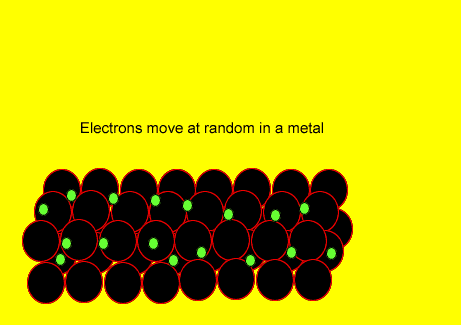
Atoms tend to keep a tight hold on their electrons through strong attraction between the protons(positive) and the electrons.
Metal atoms however, find it
difficult to hold all their electrons and always tend to allow one or
two of them to move from atom to atom. These free electrons are what makes
metals such good conductors.
Electrons in a wire travel at about 2-3 million kilometers an hour, at room temperature. This is very fast indeed but does not produce a current because their motion is random. There is no overall flow in any particular direction.
But when a battery is connected across the wire the electrons are forced to move in one direction producing a current.
As the electrons gain speed they bump into the stationary metal atoms and transfer some of their kinetic energy (moving energy) into them. As the metal atoms absorb energy from the electrons they start to vibrate strongly and heat is generated. This is why a wire becomes hot when a current is passed through it.
